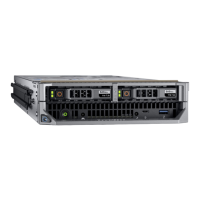CAUTION: The memory modules are hot to touch for some time after the server module has been powered down.
Allow time for the memory modules to cool before handling them. Handle the memory modules by the card edges and
avoid touching the components.
5. Reseat the memory modules in their sockets.
6. Close the server module.
7. Install the server module in the enclosure.
8. Run the appropriate diagnostic test. For more information, see the Using system diagnostics section.
If the test fails, see the Getting help section.
Related References
Getting help on page 133
Using system diagnostics on page 122
Related tasks
Removing a server module on page 52
Removing the system cover on page 56
Installing the system cover on page 57
Installing a server module on page 54
Troubleshooting hard drives
Prerequisites
CAUTION:
Many repairs may only be done by a certified service technician. You should only perform troubleshooting and
simple repairs as authorized in your product documentation, or as directed by the online or telephone service and
support team. Damage due to servicing that is not authorized by Dell is not covered by your warranty. Read and follow
the safety instructions that are shipped with your product.
CAUTION: This troubleshooting procedure can destroy data stored on the hard drive. Before you proceed, back up all
the files on the hard drive, if possible.
Steps
1. Run the appropriate controllers test and the hard drive tests in system diagnostics.
If the tests fail, go to step 3.
2. Take the hard drive offline and wait until the hard drive indicator codes on the drive carrier signal that the drive may be removed
safely, then remove and reseat the drive carrier in the server module.
3. Restart the server module, enter the System Setup and confirm that the drive controller is enabled.
4. Ensure that any required device drivers are installed and are configured correctly.
NOTE: Installing a hard drive into another bay may break the mirror if the mirror state is optimal.
5. Remove the hard drive and install it in the other drive bay.
6. If the problem is resolved, reinstall the hard drive in the original bay.
If the hard drive functions properly in the original bay, the drive carrier could have intermittent problems. Replace the drive carrier.
7. If the hard drive is the boot drive, ensure that the drive is configured and connected properly.
8. Partition and logically format the hard drive.
9. If possible, restore the files to the drive.
If the problem persists, see the Getting help section.
Related References
Getting help on page 133
Hard drive or SSD indicator patterns on page 11
128
Troubleshooting your system

